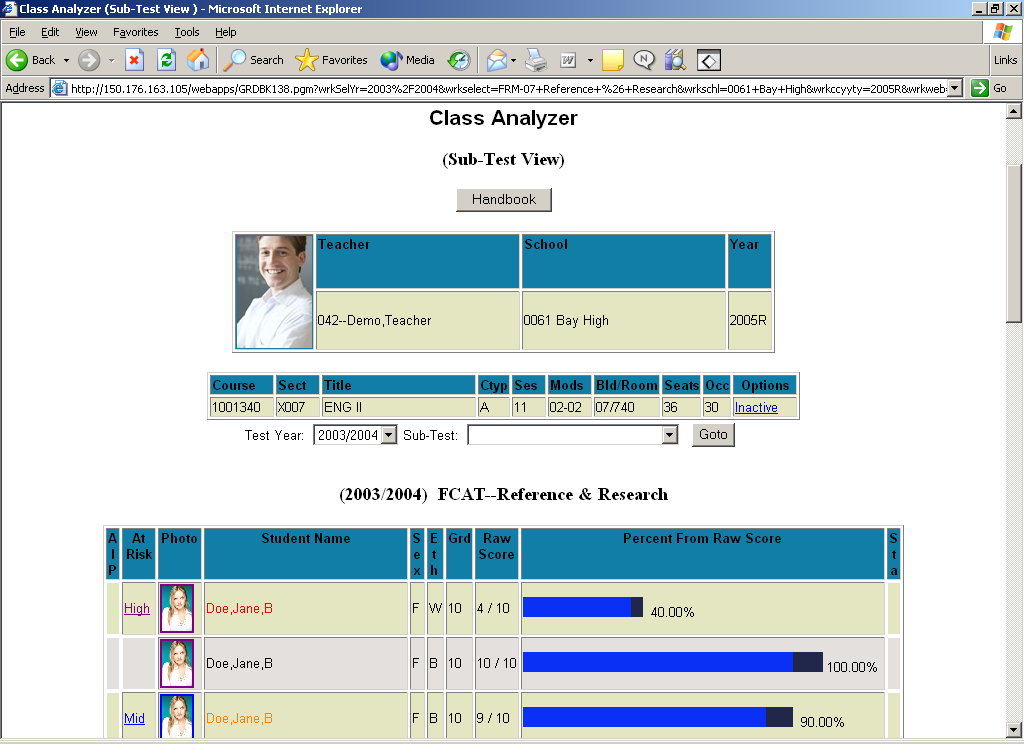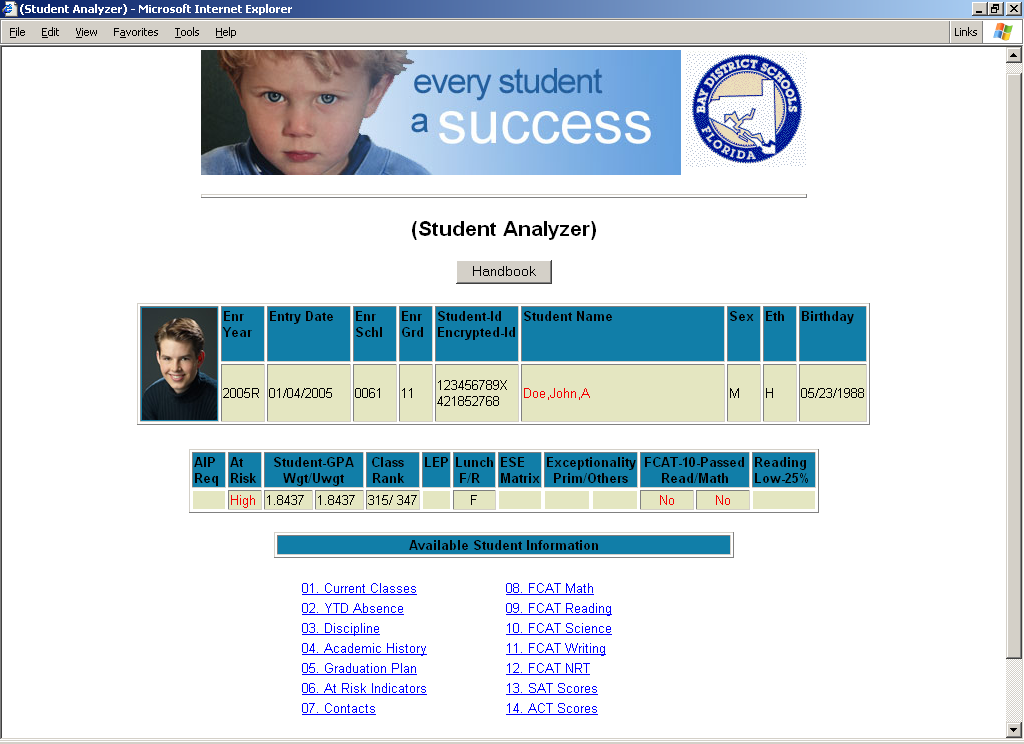All of the 28,000 students who attend school in Bay County, Florida, have academic profiles that reside on the school district's iSeries Model 830 located in Panama City. Accessible by teachers, counselors, and administrators through a Web-based portal called Dash-Board, these profiles contain academic information, assessment results, and a current photograph so that teachers, whose job it is to make sure that students get the best education possible given the tax dollars that flow into the system, can tailor curriculum to the learner's strengths and weaknesses.
In seconds, teachers and others with a user ID and password can access a student's information from a common Web browser. Greg Alford, Dash-Board's chief builder, is understandably proud. As it happens, Alford, a Cobol programmer by trade, has circuitously helped virtually every child in his school district. Alford wrote Dash-Board using ProGen WebSmart, an iSeries/i5 Web-based application development tool from Business Computer Design.
Fresh Face
Though most of Bay County's 2,131 educators relish intellectual challenges, they often sighed as they worked with the green-screen user interface. The back-end, iSeries-based applications, which have evolved over the course of 20 years and are shared by all of Bay County's 38 schools as well as many other school districts in the state, did exactly what they were supposed to do, which was gather and organize an extensive amount of data, as required by Florida state law. The problem in this case was the user interface. Alford recalls, "We were happy with our database. All we needed to do was repackage that data."
The project to build a new user interface that offered better utilization of Bay County School District's expansive data warehouse was a challenge posed by school Superintendent James McCalister to IT Director David Smith. "Superintendent McCalister wanted two things," said Smith. "The first was a way to access all the data that the district had relating to students at risk and present it to teachers who were in the best position to help students. The second thing he wanted was to do it fast."
McCalister instructed Alford to explore several options, including IBM's WebSphere. In the end, Alford said, "We felt that WebSphere was just a few years aged. They have not kept their product up-to-date, and WebSmart was a few years ahead of them. A product should become more user-friendly as it evolves, and WebSphere wasn't. When we compared them side by side, we knew WebSmart was the best product hands down, so we decided to go with it."
To close the deal with Smith, Alford wrote a small demo version of the portal. "It's really important for developers to get a working demo copy of the product for testing. BCD let us have the demo package long enough to let us do some up-front development and prove our case," he said. With no formal WebSmart training, he quickly built a working model application that accessed live data. "I figured out how it worked by experimenting with the application templates. Within a short amount of time, I understood how the product flowed and was able to write complex programs."
Frequently during this project, Alford used WebSmart's PML programming language to fine-tune the user interface. "As a COBOL programmer, it was completely new to me but very intuitive. It didn't take me very long to understand it. If I needed to do something new, I was able to go to the manual and look it up." Alford said there were about four times when he needed to call tech support for guidance. "There were things I just didn't know how to do, but BCD has the best help desk in the world. You are talking to developers there; you're talking to experienced people who know how to write code, not people who just know manuals."
In designing the portal, Alford and other members of Bay County School District's 20-person IT department sorted out important features from those less critical. "We tried to figure out exactly what critical information needs existed for a particular job, like a teacher or a counselor. We asked what information a teacher would need on her students to improve the education for each individual student."
Everyone Wins
When a teacher signs on now, Dash-Board displays all of the classes that he or she is currently responsible for. One Dash-Board component is a Class Analyzer (shown in Figure 1), which displays composite performance information for specific classes and compares it to standards defined by the state Board of Education.

Figure 1: The Class Analyzer panel gives the teacher or administrator a fast, comprehensive overview of the strengths and weaknesses of a class. (Click images to enlarge.)
Then, a Student Analyzer module (Figure 2 below) lets teachers drill down on student performance by name. Teachers can review a student's performance by clicking on the student's photograph. Alford's application analyzes 17 different key academic performance parameters nightly. The results then trigger green, yellow, or red indicators, depending on how well or poorly a student's skills are developing in specific areas. With a mouse click, Dash-Board displays standard testing results, current grades, academic history, attendance information, and where a student stands on meeting the graduation plan for all the courses that are required by the state. Alford explains that he even used WebSmart to develop graphs that illustrate how students perform year to year in math, science, reading, and writing. "Most teachers see as many as 120 different students throughout the day, and it's hard to know which students are struggling. While this information is available through the green-screens, in most cases it would require intimate knowledge of the database to get at it without the WebSmart-developed system. Now, we are repackaging the student information and presenting it in a format that is far easier to understand."

Figure 2: The Student Analyzer screen allows teachers to tailor the curriculum to the student.
The overwhelming majority of educators in Bay County have embraced Dash-Board. "A few prefer the old traditional ways," says Alford, adding, "but most of them are now online." Dash-Board's acceptance has resulted in a longer project list for Bay County's IT department. "We have spun off several sidebar applications of this new system and have received over 120 requests for additional upgrades and new programs."
The iSeries, more frequently thought of as an apt computing platform for manufacturing and distribution environments, adapts to a multitude of other tasks when applications and UIs are tailored to them. In this instance, WebSmart's technology lets educators swiftly comb an expansive iSeries data warehouse that would be inaccessible without the point-and-click, Web-based Dash-Board front-end. Alford is now showing his solution to other school districts in the state. "We are on the cutting edge with Web development, and other school districts in our state are looking at our work closely and are now considering going with WebSmart and the iSeries. Both WebSmart and the iSeries have earned an A+ from Bay District Schools."
BCD, a charter member of IBM's iSeries Developer's Roadmap offers complete product details and free evaluations on all of its software products. Please visit the BCD Web site, send your request to
Robert Gast has had an extensive number of articles published on technology and business management-related issues. He is the managing partner of Chicago area-based Evant Group and can be reached at

Business Computer Design, Int'l, Inc. (BCD)
Contact: Eric Figura, Director, Sales and Marketing
950 N. York Rd.
Hinsdale, IL 60521-2950
Tel: 630.986.0800
Fax: 630.986.0926
Web: www.bcdsoftware.com
Email:











 Business users want new applications now. Market and regulatory pressures require faster application updates and delivery into production. Your IBM i developers may be approaching retirement, and you see no sure way to fill their positions with experienced developers. In addition, you may be caught between maintaining your existing applications and the uncertainty of moving to something new.
Business users want new applications now. Market and regulatory pressures require faster application updates and delivery into production. Your IBM i developers may be approaching retirement, and you see no sure way to fill their positions with experienced developers. In addition, you may be caught between maintaining your existing applications and the uncertainty of moving to something new. IT managers hoping to find new IBM i talent are discovering that the pool of experienced RPG programmers and operators or administrators with intimate knowledge of the operating system and the applications that run on it is small. This begs the question: How will you manage the platform that supports such a big part of your business? This guide offers strategies and software suggestions to help you plan IT staffing and resources and smooth the transition after your AS/400 talent retires. Read on to learn:
IT managers hoping to find new IBM i talent are discovering that the pool of experienced RPG programmers and operators or administrators with intimate knowledge of the operating system and the applications that run on it is small. This begs the question: How will you manage the platform that supports such a big part of your business? This guide offers strategies and software suggestions to help you plan IT staffing and resources and smooth the transition after your AS/400 talent retires. Read on to learn:
LATEST COMMENTS
MC Press Online